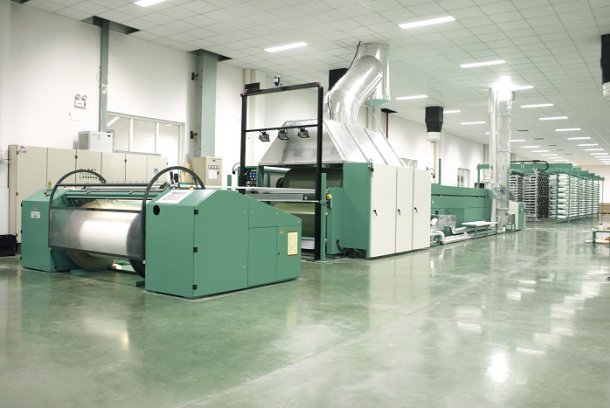-300x192-cropped.jpg)
New shoe fabric patterns with COP 5 M-EL
The huge demand for electronic components is generating good business for the printed circuit board industry and its supply chain.

5th June 2018
Innovation in Textiles
|
Obertshausen
The huge demand for electronic components is generating good business for the printed circuit board industry and its supply chain, especially in China – most of all the Copper Clad Laminates (CCLs), which are the copper-laminated precursors of printed circuit board production, are supplied by Chinese companies.
Woven glass fabrics are mainly used as the carrier material in the production of CCLs. As computers, mobile phones and other electronic devices are becoming smaller all the time, so that the components used inside them are also becoming smaller. The trend towards miniaturisation and the increasing demand for flexible CCL types require finer and finer woven glass fabrics. Glass yarns having increasingly smaller counts have to be processed to meet this demand – a challenge that is making Karl Mayer’s warp preparation machines ever so popular in China.
Karl Mayer, a leading German textile machinery producer, has been operating successfully on the Chinese woven glass fabric market with its sizing and warping machines. At the end of 2016, the electronics supply industry really started to take off and the first big orders were placed. This was followed by more big orders in the autumn of 2017 which, according to Oliver Posselt, a Sales Manager, was completely unexpected.
“With the first wave of orders, we were starting from a position of a modernisation backlog in the sector,” he said. “This recent demand accounts for the optimism of manufacturers. Companies are convinced that this trend will continue. Prospects are good for 2018 and 2019 as well. The buyers include many existing customers, who are expanding or upgrading their capacity, but also companies that are new to the woven glass fabric sector.”
Karl Mayer’s warp preparation process uses the principle of single end sizing: the yarns are taken off from bobbins, fed through the sizing bath, dried, and wound onto beams. These are then assembled to produce warp beams for weaving. Karl Mayer can supply the right machine technology for every processing stage. In the initial stage, the glass rovings are gently removed from creels with the aid of the Accutense computer-controlled, hysteresis yarn tensioner and fed to the Filesize sizing machine.
This machine for processing filament yarns also focuses on process control without any loss of quality. It processes a maximum of just 800 yarns – fewer than full warp sizing machines. These do not come into contact during the treatment process, so that they are sized all over. The yarns, which are processed separately, cannot stick together in the drying zone. The separation process, which normally has to be carried out when sizing full warps and which frequently damages the glass fibrils, is now superfluous.
The Filesize also scores points with its accurate yarn tension control during yarn transportation – an important feature, since the non-stretch glass yarn cannot tolerate any fluctuations in tension, the company reports. If the tension decreases, there is a danger of loose yarns, whereas if it is too high, the yarns can be damaged. To rule this out completely, the yarn tension is monitored and controlled at several places, such as in the size box and at the entry and exit points of the drying stretch.
The zone for removing the water from the glass comprises a modern hot-air oven and a subsequent drying cylinder zone. It is important to carry out pre-drying in the hot-air oven to enable the flat cross-section of the wet yarn to take on a circular shape. The temperature of the drying cylinders is 90 to 145°C and it is monitored and controlled accurately. This accurate temperature control is needed to guarantee top processing quality and for the sectional warp beams to have a high sized quality. Four to six sectional beams are then combined to produce the warp beams destined for weaving.
In addition to meeting the highest quality requirements, the Filesize operates at an exceptionally high level of productivity, according to the manufacturer. This is due to its exceptional operating reliability and unique output. This warp preparation machine operates at a rate of 250 m/min-1 when processing glass under practical conditions.
The warp preparation sequence for processing glass can be adapted flexibly to suit the intended end-use, especially in terms of the tension regulation and the arrangement of the drying zone. For example, the number of drying cylinders can be varied as a function of the yarn count. “Five cylinders are usual for average counts, whereas three are sufficient for very fine counts,” explained Oliver Posselt.
The coarsest types that still need to be sized have counts of 75 tex. He goes on to say, however, that fine yarns are more interesting and in higher demand. “Our customers are currently talking about 5 tex down to 1.3 tex. The challenges associated with this require a completely new type of technology. We are in an excellent position to lead the way here,” said Sales Manager. A machine for processing extremely fine glass yarns was successfully installed in February 2018.

Business intelligence for the fibre, textiles and apparel industries: technologies, innovations, markets, investments, trade policy, sourcing, strategy...
Find out more